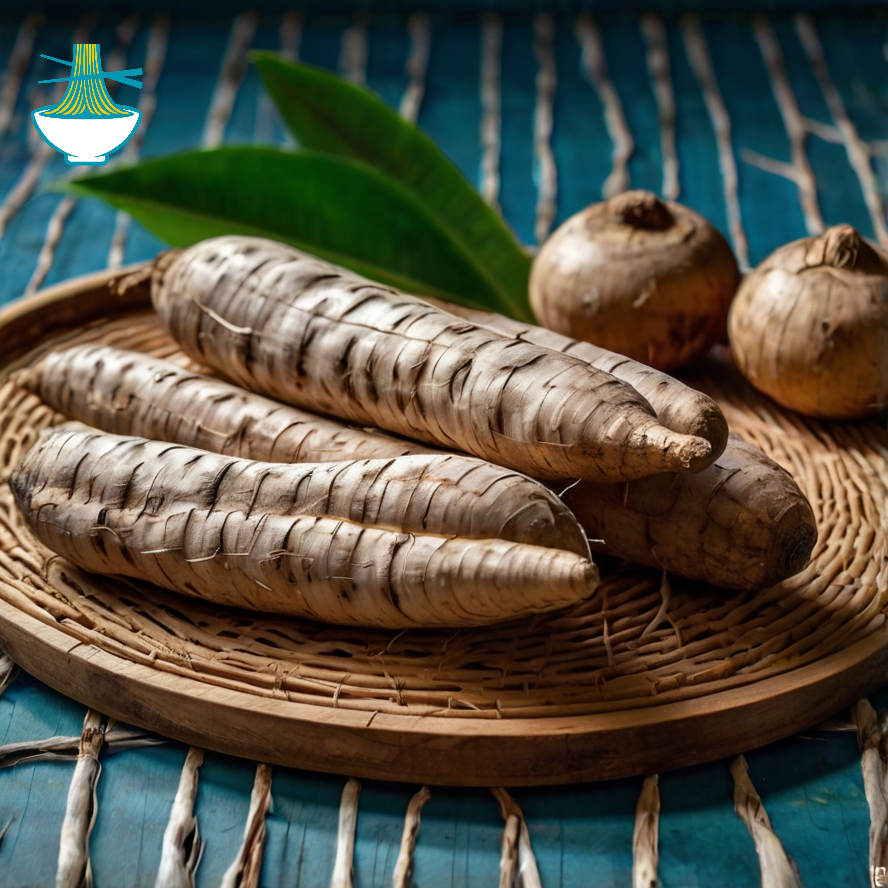Kiribati Cassava, also known as manioc or yuca, is a versatile and essential ingredient in Kiribati's traditional cuisine. This starchy root vegetable, originating from South America and introduced to Kiribati by European explorers, has become deeply integrated into the culinary practices of the islands. In Kiribati, cassava is used in a variety of dishes, from simple boiled cassava served with coconut milk to more elaborate preparations such as cassava cakes and breads. Its neutral flavor and hearty texture make it an excellent substitute for potatoes or rice. Discover the rich history and flavorful possibilities of Kiribati Cassava in your next culinary adventure.
Here's a simple yet delicious recipe for Kiribati Cassava:
Kiribati Cassava with Coconut Milk
Ingredients:
- 1 large Kiribati cassava root
- 1 can (400ml) coconut milk
- Salt, to taste
- Water
- Optional: chopped fresh cilantro or parsley for garnish
Instructions:
Preparation of Cassava:
1- Peel the tough outer skin of the cassava root using a sharp knife.
2- Cut the cassava into manageable pieces, about 2 inches in length.
Boiling Cassava:
1- Place the cassava pieces in a large pot and add enough water to cover them.
2- Add a pinch of salt to the water.
3- Bring the water to a boil over medium-high heat, then reduce the heat to medium-low and let it simmer for about 20-25 minutes, or until the cassava is fork-tender.
Making Coconut Milk Sauce:
1- While the cassava is cooking, pour the coconut milk into a separate saucepan.
2- Heat the coconut milk over medium heat, stirring occasionally. Do not let it boil.
3- Season the coconut milk with a pinch of salt to taste.
Combining Cassava and Coconut Milk:
1- Once the cassava is tender, drain the water and transfer the cooked cassava to a serving dish.
2- Pour the warm coconut milk over the cassava.
3- Gently toss the cassava in the coconut milk to coat evenly.
Serving:
1- Garnish with chopped fresh cilantro or parsley if desired.
2- Serve the Kiribati Cassava with Coconut Milk warm as a side dish or a light main course.
Enjoy the creamy texture of the cassava paired with the richness of coconut milk in this traditional Kiribati dish!
Nutritional Values:
Here are approximate nutritional values for the main ingredients used in the Kiribati Cassava with Coconut Milk recipe:
1 Large Kiribati Cassava Root (about 1 lb or 450g):
- Calories: 330 kcal
- Fat: 0.5 g
- Carbohydrates: 80 g
- Protein: 2 g
Benefits:
- Carbohydrates: Provides a significant source of energy.
- Fiber: Supports digestive health.
- Vitamins: Contains small amounts of vitamin C, B vitamins, and minerals like potassium.
1 Can (400ml) Coconut Milk:
- Calories: 400 kcal
- Fat: 44 g
- Carbohydrates: 6 g
- Protein: 4 g
Benefits:
- Healthy Fats: Provides medium-chain triglycerides (MCTs) which may support metabolism.
- Electrolytes: Contains potassium and magnesium.
- Flavor: Adds a rich, creamy texture.
Salt, to Taste
- Calories: 0
- Fat: 0
- Carbohydrates: 0
- Protein: 0
Benefits:Flavor Enhancement: Enhances the overall taste of the dish.
Water:
- Calories: 0
- Fat: 0
- Carbohydrates: 0
- Protein: 0
Benefits:Hydration: Necessary for cooking and achieving the desired consistency.
Optional: Chopped Fresh Cilantro or Parsley for Garnish:
- Chopped Cilantro:
- Calories: 5 kcal (for a small handful)
- Fat: 0 g
- Carbohydrates: 1 g
- Protein: 0.5 g
Benefits: Adds freshness and may aid digestion.
Chopped Parsley:
- Calories: 4 kcal (for a small handful)
- Fat: 0 g
- Carbohydrates: 1 g
- Protein: 0.5 g
Benefits: Provides a fresh flavor and is high in vitamins A and C.
Please note that these values are approximate and can vary based on the specific brands of ingredients used and their preparation methods.


Comments